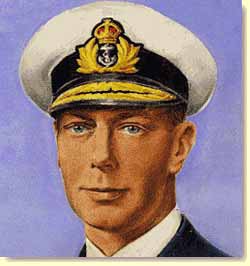 |

|
"If the 'greatness' of a King can be measured by the extent to which his qualities correspond to the needs of a nation at a given moment in its history, then George VI was a great King, and perhaps a very great King."- René Massigli, French Ambassador, 1952 George VI was the second son of King George V and Queen Mary who succeeded to the throne in the unprecedented circumstances of the abdication of his popular brother, King Edward VIII, in 1936. Overcoming the handicaps of ill-health, shyness and a bad stammer, and in a reign characterised by war, social change and the beginnings of the dissolution of the British Empire, he was a successful king who raised the prestige of the monarchy and left his daughter, Elizabeth, a stable throne. The British monarchy continued to evolve in the twentieth century, shedding many of its Germanic links in the First World War when, in 1917, King George V decided to change the family name to Windsor. Its constitutional role was also changing as the Empire began to move to self-governing Dominion status in which the crown became "the symbol of the free association of the members of the British Commonwealth of Nations", in the words of the 1931 Statute of Westminster. George’s brother, Edward VIII, succeeded to his father’s throne in 1936, although George V had predicted to Prime Minister Stanley Baldwin the year before that "after I am dead the boy will ruin himself in six months". Edward was a popular personality but government ministers were concerned about his tendency to interfere in policy-making and his pro-German sympathies, which seemed to run against the constitutional position that the king was only supposed to act with their advice. The problem crystallized over his determination to marry the American divorcee, Wallis Simpson, against the advice of his ministers and that of the Prime Ministers of the Dominions. The monarchy had also become a symbol of family life and moral standards and divorce was then regarded as morally repugnant. Edward, seeing the choice as one between his throne and the woman he loved, abdicated on December 11th 1936. George VI, who succeeded him, was a conscientious and dedicated man, who applied himself to a role he had never anticipated. He had married Elizabeth Bowes-Lyon in 1923 and their eldest daughter, Elizabeth, was born in 1926. As President of the Industrial Welfare Society he had sought to improve the working conditions of ordinary workers, through canteens, medical care and other benefits, leading one 1920s trade unionist to comment that no one else of comparable position had done so much to "establish and maintain harmonious relationships between employers and workmen". George VI was able to stabilize the monarchy after the unsettling abdication crisis and, in 1939, with the outbreak of World War Two he was propelled into the limelight. War would serve to enhanced the importance of the Crown as a unifying symbol of the nation and Empire and strengthen the link between the monarch and his subjects. As his biographer, Sarah Bradford, has written - "He, with the Queen and Winston Churchill, were to be seen as the spirit of an embattled Britain and her Empire". Prime Minister Churchill described the war-time monarchy as "the true bulwark of British freedom against tyrannies of every kind". George had served with the Royal Navy during World War One, and seen some action at the Battle of Jutland, however, although he was Head of State and Commander-in-Chief of the Armed Forces, his role was technically symbolic, although he did have access to top-secret information. The King and his wife (later famous in her own right as 'The Queen Mother') remained at Buckingham Palace throughout the war, although it was bombed on nine separate occasions. They both made a point of visiting severely bombed sites all over the country, including the East End, which enhanced their reputation in the eyes of the general public. He wrote in his diary that "we have both found a new bond with them as Buckingham Palace has been bombed as well as their homes, & nobody is immune". Time magazine declared that "never in British history has a monarch seen and talked to so many of his subjects or so fully shared their life". In recognition of civilians and their service in this new modern "total war", the King instituted two civilian gallantry awards. As a decoration equivalent to the Victoria Cross for servicemen, the George Cross, for conspicuous gallantry, and the George Medal for devotion to duty. King George was also anxious to visit the "fighting teeth" of the Services and took every opportunity to do so; inspecting the British Expeditionary Force in France 1939 and in North Africa after Montgomery’s victory over Rommel in 1943. Ten days after the Normandy landing, the King was seen making a tour of the newly captured beaches. On VE day Buckingham Palace provided the focal point of celebrations. After the war George VI made a major tour of South Africa, the first by any monarch, accompanied by his family. In 1947 Indian and Pakistan became independent and George lost his title Emperor of India. However, the evolving British Commonwealth of Nations was to be linked by a common recognition of the Sovereign as Head of the Commonwealth. After an unsuccessful lung operation the King died on 6 February 1952 at Sandringham aged 56. The funeral took place at St. George’s Chapel, Windsor where his remains are buried. With the Government’s funeral wreath was a card inscribed by Winston Churchill, which read "For Valour". This phase is also to be found on that highest of military awards, the Victoria Cross. |












